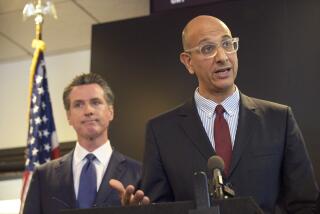Doctor Makes the Rounds for His Causes : Profile: O.C. surgeon turns his outrage into action against gang violence, drunk driving.
- Share via
MISSION VIEJO — Kathy Woods was mystified. After keeping a bedside vigil for her comatose 17-year-old son, speared through the head in a suspected San Clemente gang attack, she was confronted by a surgeon with a strange request.
Instead of trying to comfort her, the doctor urged Woods to help him publicize the attack at a news conference he had called.
“I thought the man was crazy. I thought he had four heads,” Woods recalled of her first encounter in October with Dr. Thomas E. Shaver, director of the trauma unit at Mission Hospital Regional Medical Center in Mission Viejo.
Woods believed her son Steve’s tragedy should be private. She was reluctant to display her son’s graphic X-rays, showing a paint roller rod lodged in his brain. But, ultimately, Shaver’s enthusiasm convinced her it was important to tell people how bad the gang situation had become.
It was not the first time the 57-year-old surgeon, a native of Long Beach who now lives in Mission Viejo, had persuaded others to follow his lead and share his outrage for what has become a series of Shaver causes: stopping dangerous Border Patrol chases of illegal Mexican immigrants, fighting against teen-age drunk drivers, promoting construction site safety, and speaking out against gang violence.
“I mean, we had to do something,” Shaver said in retrospect about Steve Woods, who later died of his injury. “Hey! Right now, we have a guy in this hospital who was shot in the face and he’s hanging on for life with a ventilator. It’s very simple for us--we shouldn’t be seeing this type of violence.”
It is the steam that runs the surgeon’s spiritual engine and his life. After 13 years of being an emergency room mechanic who repairs the human body, Shaver said, he feels compelled to do more than “cutting and tying” on a surgical table when doing more might prevent such human wreckage.
“Things hit a threshold,” Shaver said, philosophically. “And, we here at the hospital say, ‘That’s enough.’ There comes a point in time when things just shouldn’t happen.”
Few physicians have Shaver’s bullheaded determination to sway chambers of commerce, hospital administrators, community leaders, police officers, firefighters, council members and judges to his way of thinking.
“He is all charge. . . . He generates so much enthusiasm that you have to jump on board,” said Betty O’Rourke, program director for the Orange County Emergency Medical Services Agency.
When the Shaver threshold is breached, anger is transformed into community action. When he began seeing too many teen-agers injured in drunk driving accidents, he helped expand a dial-a-ride program that is now credited for reducing casualties. When he heard of a program to force young drunk driving offenders to visit trauma wards and the county morgue to see how victims can be maimed and killed in alcohol-related accidents, he castigated a local judge for not making use of it.
Fellow surgeons say it was Shaver’s ambition and vision that enabled him to develop a trauma center at Mission Hospital Regional Medical Center that has been praised by a national reviewing committee as a model of efficiency, innovation and cost-effectiveness.
Yet, Shaver has his detractors.
Critics question, confidentially, whether Shaver’s flair for the dramatic is best for the patients or his own priorities. A local San Clemente official, who did not want to be identified, said Shaver tends to push victimized families forward into the limelight as if they are “caught up in the tragedy of the week or month.”
Kathy Woods now believes Shaver was right about coaxing her to have that press conference, saying that “without Shaver,” her son’s shocking injury would not have sparked a movement in south Orange County to stop youth violence.
In retrospect, she said, “he did the right thing.”
Although Shaver considers himself a political conservative and believes the nation’s borders need to be protected, he jumped into the county’s immigration debate on behalf of Mexican immigrants who died or were injured while fleeing U.S. Border Patrol officers on Interstate 5.
“At one time, that stretch of freeway near the (San Clemente immigration) checkpoint had more deaths per mile that it was rated one of the country’s worst sections,” Shaver said.
The Border Patrol has limited its controversial, often high-speed chases like the one in Temecula that led to six deaths in 1992.
“Dr. Shaver had nothing to do with (changing) our chase policy,” said Ann Summers, a Border Patrol spokeswoman in San Diego. “We’ve had policy discussions concerning our chase policy and that was the reason why we had a lot less number of pursuits in San Diego and in south Orange County.”
When immigrants are injured in chases, “the medical costs are passed on to all of us, but immigration agencies should be footing the bill,” Shaver said. “If they’re chasing them, why don’t they pick them up at the hospital when they’re released. . . . They don’t cause these injuries? But they do. All these bureaucrats lie after the fact. If I didn’t speak out, it would be business as usual.”
Shaver’s outrage over injuries caused by youths who drink and drive reached a boil three years ago, once again in his trauma center. At his Mission Viejo office, he recently recalled accompanying parents from bed to bed as they tried to determine whether their children were among the survivors of a deadly head-on collision.
The incident prompted Shaver to hold a series of meetings at his Mission Viejo home and at the hospital. He and invited guests learned what programs were available that targeted drunk driving among youths.
One program, Safe Rides, seemed interesting but only involved two high schools in the Capistrano Unified School District and two in the Saddleback Valley Unified School District.
Shaver persuaded the South County school districts to consolidate their efforts. He also personally made appeals to city councils, his own hospital administration and service organizations to provide Safe Rides with more financial support so it could grow.
“I started getting checks in the mail,” said Jeff Davis, who was then vice principal at San Clemente High School and director of South County Safe Rides. Whenever outside contributions were not enough, he said, the doctor would write a personal check.
Pamela L. Iles, a judge in Municipal Court in Laguna Niguel, has witnessed Shaver’s powers of persuasiveness. She said he came to her office three years ago to chastise her for not implementing a program then being used in North County to punish young, first-time drinking and driving offenders.
“I let him go on,” she said. “I was fascinated to find someone with this kind of community commitment. . . . I was basically astounded, overwhelmed and I immediately said I will do whatever I can.”
Iles said the program Shaver pitched--which required young offenders to visit the hospital trauma center and the county morgue, and participate in a hospital program for patients with brain injuries--has helped to “break down the denial” of young drivers who think that a disastrous accident “can’t happen to them.”
Perhaps Shaver’s most challenging campaign is his attempt to stem South County’s growing gang problem. The genesis occurred last June, soon after he had treated a teen who nearly died of a stab wound. Another San Clemente youth had arrived at the hospital with a large butcher knife sticking in his back.
“It just pissed me off that it happened. I said, ‘Where the hell is the mother?’ I wanted to talk to her,” Shaver said.
He said the mother showed up with the injured youth’s 8-year-old brother, who already had a gang tattoo on his hand. Then a group of 20 boys wearing the baggy pants and baseball hats typical of gangs strutted in to visit their fallen friend.
“And that’s how I met Raul,” Shaver recalled. Raul, 17, the member of a San Clemente street gang, accepted Shaver’s invitation to meet later to discuss how to stop gang killings.
The doctor and Raul seemed worlds apart when they met some weeks later at Splashes, a trendy Laguna Beach restaurant.
Shaver, who has five children, exchanged pleasantries with Raul, and quickly began giving him the third degree.
“Tell me about yourself. Where were you born? You grew up without a father? Where is he?” he said to the youth.
Later, Shaver announced, “Well, Raul, I want you to know you’re here for a purpose. I picked you out because I believe that you have a lot of leadership potential.
“But you know, we have to stop this violence,” he told Raul. “It can’t go on.”
After the dinner, Raul said Shaver did not seem to appreciate all the obstacles facing a gang member who wants to reform, but he said the doctor had a sincerity about him, “where other people just criticize us. They just want to get rid of us.”
Iles, who knows Shaver and his passion, said she believes he may succeed where others have failed or given up without trying.
“I wouldn’t put it past him,” she said. “The naivete he has is part of his energy. He sees a better and larger world, he knows how to mobilize resources and he never gives up.”
Profile: Dr. Thomas E. Shaver
Age: 57
Hometown: Long Beach
Family: Wife Diane and five children
Military service: Air Force, 1954-58
Medical degree: University of Kansas, 1965
Internship and residency: L.A. County-USC Medical Center, 1965-1970
Board certification: American Board of Surgery, May, 1971
Attitude: “When you look in your (intensive care unit) and see two or three people with gunshot wounds or stab wounds, you know something is not right in this community.”
Source: Thomas Shaver
More to Read
Sign up for Essential California
The most important California stories and recommendations in your inbox every morning.
You may occasionally receive promotional content from the Los Angeles Times.










